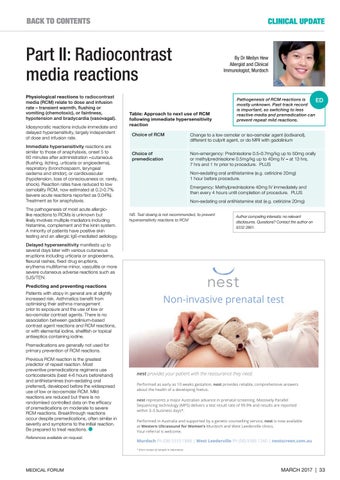BACK TO CONTENTS
CLINICAL UPDATE
Part II: Radiocontrast media reactions Physiological reactions to radiocontrast media (RCM) relate to dose and infusion rate – transient warmth, flushing or vomiting (chemotoxic), or faintness, hypotension and bradycardia (vasovagal). Idiosyncratic reactions include immediate and delayed hypersensitivity, largely independent of dose and infusion rate. Immediate hypersensitivity reactions are similar to those of anaphylaxis, onset 5 to 60 minutes after administration –cutaneous (flushing, itching, urticaria or angioedema), respiratory (bronchospasm, laryngeal oedema and stridor), or cardiovascular (hypotension, loss of consciousness or, rarely, shock). Reaction rates have reduced to low osmolality RCM, now estimated at 0.2-0.7% (severe acute reactions reported as 0.04%). Treatment as for anaphylaxis. The pathogenesis of most acute allergiclike reactions to RCMs is unknown but likely involves multiple mediators including histamine, complement and the kinin system. A minority of patients have positive skin testing and an allergic IgE-mediated aetiology.
By Dr Meilyn Hew Allergist and Clinical Immunologist, Murdoch
Table: Approach to next use of RCM following immediate hypersensitivity reaction
Pathogenesis of RCM reactions is ED mostly unknown. Past track record is important, so switching to less reactive media and premedication can prevent repeat mild reactions.
Choice of RCM
Change to a low osmolar or iso-osmolar agent (iodixanol), different to culprit agent, or do MRI with gadolinium
Choice of premedication
Non-emergency: Prednisolone 0.5-0.7mg/kg up to 50mg orally or methylprednisolone 0.5mg/kg up to 40mg IV – at 13 hrs, 7 hrs and 1 hr prior to procedure. PLUS Non-sedating oral antihistamine (e.g. cetirizine 20mg) 1 hour before procedure. Emergency: Methylprednisolone 40mg IV immediately and then every 4 hours until completion of procedure. PLUS Non-sedating oral antihistamine stat (e.g. cetirizine 20mg)
NB. Test dosing is not recommended, to prevent hypersensitivity reactions to RCM
Author competing interests: no relevant disclosures. Questions? Contact the author on 9332 2861.
Delayed hypersensitivity manifests up to several days later with various cutaneous eruptions including urticaria or angioedema, flexural rashes, fixed drug eruptions, erythema multiforme minor, vasculitis or more severe cutaneous adverse reactions such as SJS/TEN. Predicting and preventing reactions Patients with atopy in general are at slightly increased risk. Asthmatics benefit from optimising their asthma management prior to exposure and the use of low or iso-osmolar contrast agents. There is no association between gadolinium-based contrast agent reactions and RCM reactions, or with elemental iodine, shellfish or topical antiseptics containing iodine. Premedications are generally not used for primary prevention of RCM reactions. Previous RCM reaction is the greatest predictor of repeat reaction. Most preventive premedications regimens use corticosteroids (best 4-6 hours beforehand) and antihistamines (non-sedating oral preferred), developed before the widespread use of low or iso-osmolar RCM. Mild reactions are reduced but there is no randomised controlled data on the efficacy of premedications on moderate to severe RCM reactions. Breakthrough reactions occur despite premedications, often similar in severity and symptoms to the initial reaction. Be prepared to treat reactions. References available on request.
MEDICAL FORUM
MARCH 2017 | 33
